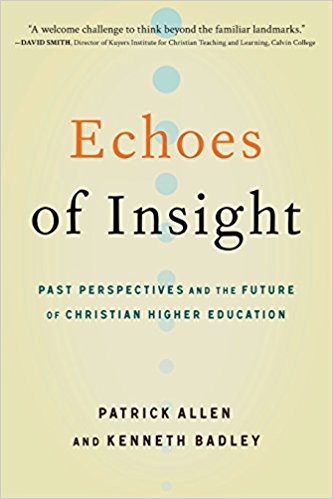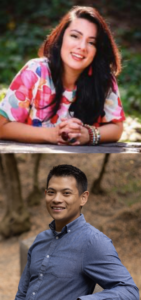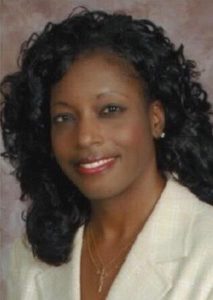spiritual formation
Select an item by clicking its checkbox
One exercise that has sustained me throughout these last three years of a global pandemic has been writing letters to my Beloveds. As a child who was always on the move, inhabiting la frontera, physically and intellectually, writing to friends in my home country was a way to remain grounded ...
Teaching and learning in academic settings can sometimes appear contrived or artificial in relation to the “real” world or professional contexts for which students prepare. However, this does not always have to be the case. One of the things that has surprised me about teaching in theological education is the ...

Echoes of Insight: Past Perspectives and the Future of Christian Higher Education
Date Reviewed: December 12, 2017
In Echoes of Insight: Past Perspectives and the Future of Christian Higher Education, co-authors Patrick Allen and Kenneth Badley mine voices from the past for fresh wisdom to assist Christian universities in their efforts to balance programming (glitz), the pursuit of truth (glue), and the goal of being transforming institutions “for the sake of the Kingdom (300)” (hope).
The text is a response of hope, intended to refocus the mission, identity, and curriculum of Christian universities on its well-being and its ultimate purpose, which is "to provide a clear and rigorous program of instruction, spiritual formation, and vocational preparation (255).” The text, therefore, proposes a distinct move away from the sometimes exclusive, albeit important, conversations around money, branding, and jobs for graduates. To do this work, the authors examine eleven influential thinkers of education. Using a format that very closely resembles the multiple editions of Daniel L. Pals’s Theories of Religion, each chapter in Echoes of Insight offers a brief biography, a synopsis of classic and relevant works, a discussion of applicable ideas, and questions for reflection.
Part One: “The Classroom and the Student Instruction, Formation, and Vocation,” introduces five thinkers and attempts to connect their ideas with the perceived “challenges faced by Christian higher education in the twenty-first century (18).” Part One begins with Alfred North Whitehead, but the works of Dorothy Sayers, Hannah Arendt, Flannery O’Connor, and Maria Montessori, via their respective chapters, come alongside to help to facilitate a larger discussion on the human experience and the current challenges faced by Christian universities. Cooperatively, these works support Whitehead’s claim that “all parts of a student’s education should fit together epistemologically and should connect to the student’s day-to-day life (29).” In other words, how faculty members treat students, how colleagues convey mutual respect, or where the roots of authority lie all contribute to the students’ learning experience.
Part Two: “The Faculty and the Administration: Mission, Vision, and Values,” examines the work of John Henry Newman, Abraham Flexner, Thorstein Veblen, Jose Ortega y Gasset, Robert Maynard Hutchins, and Karl Jaspers. Unlike Part One, the thinkers included in Part Two are those who had a vested interest in higher education and maintained distinct ideas about the university and the pursuit of truth. Allen and Badley found that all agreed that a common mission, a strong academic program, an emphasis on learning, and the freedom to pursue truth were essential.
Overall, the text is an enjoyable read. In fact, although it is written for a scholarly audience, the authors’ often tongue-in-cheek humor makes the manuscript a rather accessible and entertaining page-turner. More importantly, the authors’ passion and genuine interest in the success of Christian higher education makes Echoes of Insight both engaging and insightful.
Echoes of Insight is an important work and a valuable addition to this area of scholarship. Thankfully, the authors are already planning a more inclusive and diverse second edition, because the current text falls short in these areas. Indeed, the glaring absence of writers, theologians, or philosophers of color is problematic. Such an omission not only silences and makes invisible select people groups, but it also disregards the distinct experiences of minority students on predominantly white Christian campuses. Consequently, this text, whose argument is predicated on integration, connection, and the unhindered pursuit of truth, failed to take seriously just how much race and racism in American education and American Christianity unjustly impacts people of color and negatively informs their day-to-day life and learnings experiences. Thereby rendering many of them grossly untouched by Allen and Badley’s vision of a transformational institution.
Given the philosophical and theoretical emphases of Echoes of Insight, graduate students and specialists (namely faculty and administrators) with scholarly interests in this subject matter would benefit most from reading this text.
As finals week draws near, Dr. Roger Nam of George Fox University, Dr. Eric Barreto of Luther Seminary, and Dr. Kate Blanchard of Alma College discuss how they, as teachers and educators of theology and religion, prepare to give final exams.

The Quest for Meaning and Wholeness: Spiritual and Religious Connections in the Lives of College Faculty
Date Reviewed: December 23, 2014
Jennifer A. Lindholm begins her work on the spiritual proclivities and religious perspectives of college faculty in the United States by noting that they teach in a “spiritually engaged nation” where nine in ten adults profess belief in God or a Universal Spirit (1). Religion is ubiquitous in American life – 80 percent of Americans consider religion as important to their lives – but it is also a complex and contested matter that fosters community and generates conflict across the country.
Although college students are no different than other Americans in their spiritual and religious seeking – three in four college students are “searching for meaning and purpose in life” – Lindholm argues that they are not receiving sufficient instruction and mentoring from their professors. Two-thirds of college students report that their professors “never” encourage discussion of religious topics and nearly half are dissatisfied with how their college experience has provided opportunities for spiritual reflection (212). Yet Lindholm astutely demonstrates that college professors are no less spiritual or religious than their students. Drawing upon a 2012 survey of 8,447 tenured and tenure-track faculty from 264 diverse colleges and universities, the author finds that 19 percent of faculty self-identify as “not spiritual and not religious,” a figure only four percentage points higher than the general American population (50). Students are still disappointed in the lack of religious dialogue on their campuses in part because their professors experience competing tensions in their own attempts to incorporate their spiritual and religious lives into their work.
In the second chapter, Lindholm uses faculty perspectives to provide helpful delineations of what is meant by self-identifying as “spiritual” or “religious.” She interprets her data in the following five chapters to illumine the substantial challenges faculty face when seeking to connect the spiritual and religious dimensions of their lives in the academy. Although faculty who are able to freely and openly express their spirituality are “more likely to view themselves as being authentic in their work and personal lives,” respondents often stated that they encountered overt hostility in the form of religious discrimination from colleagues and stumbled over more subtle obstacles like institutional expectations to be available to work on weekends (ix). One of the many fascinating points in Lindholm’s study shows how faculty from all faiths and in every kind of educational institution – public, private, and religious – experience these tensions. Evangelical faculty at public schools reported the highest levels of occasional discrimination (39 percent), but faculty from other religious traditions, such as Buddhism, Islam, and progressive Christianity, explained how they felt no less like outsiders at work (126-146).
Lindholm accomplishes her primary purpose successfully and presents a rich, data-based account of the spiritual and religious lives of college faculty in the United States, and also articulates several cogent and compelling prescriptions to create “valued space for the spirit within the academy” so professors and their students can more fully connect higher education with human wholeness (216). Theological educators will also benefit from this book. Lindholm’s call for greater consideration of spiritual and religious diversity within the scope of collegiate intercultural development applies equally to seminaries with student bodies that are increasingly becoming more ethnically, racially, and theologically diverse.

